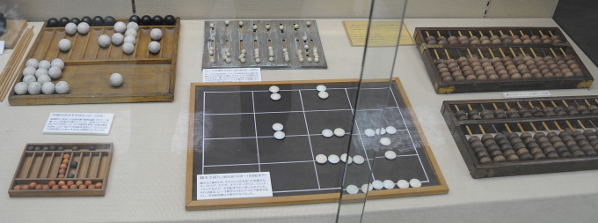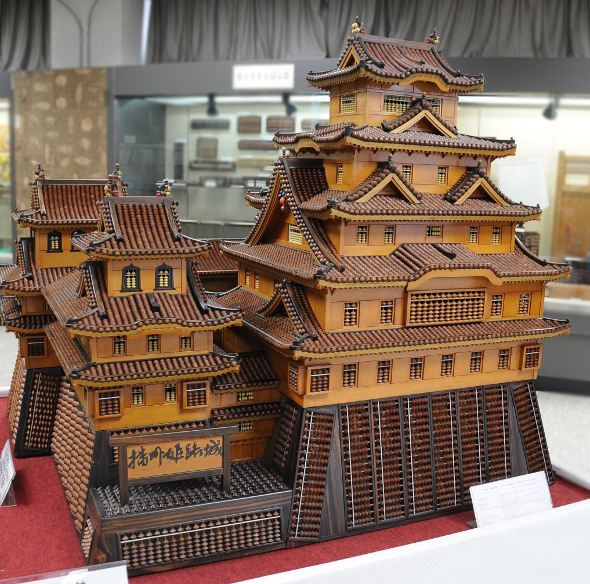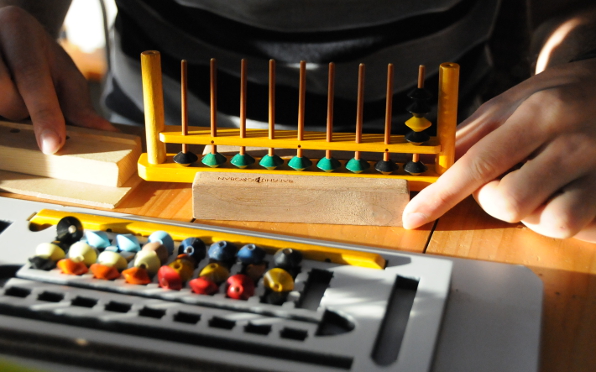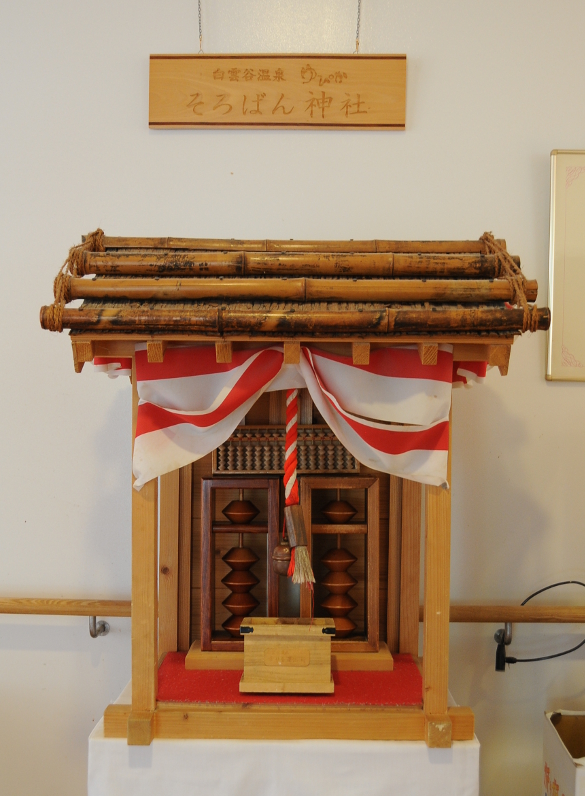As promised on Monday, here is my report about the soroban class’s trip to Ono. Ono is a small town near Kobe which calls itself the Town of Soroban. Indeed, we have visited one soroban museum, two soroban factories and one master who makes handmade soroban, there is a soroban shrine and a bridge with soroban theme, and you can buy soroban senbei… But, let’s start at the beginning.
When we arrived in Ono after a two hours drive from Kyoto, we first went to the soroban museum. There is a huge soroban showing the current year on their parking lot outside, so it is hard to miss. Their general displays were nice, but once you have seen Ogaki-san’s soroban collection, there is not much left to surprise you. I did like the display of the various roots of the soroban, from Egypt, the Middle East, and China though.
Also, somebody obviously had too much time on his hands in which he built a small model of Himeji castle out of thousands of soroban beads.  One room of the museum was dedicated to the process of soroban making, which until today is still largely manual work. There were machines on display, and photos of workers, the numerous parts of a soroban and the materials they are made of, i.e., different types of wood and bamboo. I knew that soroban beads are made from wood and are cut out of thin wooden disks, but I did not know that at that point already they would be provided with their holes…
One room of the museum was dedicated to the process of soroban making, which until today is still largely manual work. There were machines on display, and photos of workers, the numerous parts of a soroban and the materials they are made of, i.e., different types of wood and bamboo. I knew that soroban beads are made from wood and are cut out of thin wooden disks, but I did not know that at that point already they would be provided with their holes…  Afterwards, we went to see an acquaintance of sensei’s, who owns a soroban factory, and there we could see some of the machines in action. Unfortunately, this particular factory does not make the beads, but even so, there are lots of soroban in different states of completion lying around everywhere. Although the factory is quite small – there are less than 10 employees only – they produce 18.000 soroban each year – and a variety of different wood toys on top of that.
Afterwards, we went to see an acquaintance of sensei’s, who owns a soroban factory, and there we could see some of the machines in action. Unfortunately, this particular factory does not make the beads, but even so, there are lots of soroban in different states of completion lying around everywhere. Although the factory is quite small – there are less than 10 employees only – they produce 18.000 soroban each year – and a variety of different wood toys on top of that.
In this factory, you even have the possibility of making your own soroban. As this activity is geared towards kids, there are numerous colorful choices for both the frame and the beads. We were invited to make our own soroban; sensei made a red one with white beads, I made a green one with all beads in all colours of the rainbow, and here is my friend working on his yellow soroban.  We visited another soroban factory as well, where we learned that soroban making – as probably most of the crafts in Japan – has carried division of labour almost to the extreme: For a really good soroban there is one master who makes the beads, another one who produces the rods, and a third one who makes the frame. Interestingly, although they are so thin, the bamboo rods have a lighter inside and a darker outside, and it is very important that the outside of the rods (which once pointed to the outside of the bamboo plant) is installed towards the top of the soroban, as it is obviously harder than the inside…
We visited another soroban factory as well, where we learned that soroban making – as probably most of the crafts in Japan – has carried division of labour almost to the extreme: For a really good soroban there is one master who makes the beads, another one who produces the rods, and a third one who makes the frame. Interestingly, although they are so thin, the bamboo rods have a lighter inside and a darker outside, and it is very important that the outside of the rods (which once pointed to the outside of the bamboo plant) is installed towards the top of the soroban, as it is obviously harder than the inside…
Both factories naturally also had a display of soroban, from the very old to the brand new ones. My favourite was the sample that was made to showcase all the different colours of the wood – the wood here is not painted – but in the olden days, the white beads would have been made from bones or shells. 
After a short stop at a soroban master who works in his garage, we went to visit the other sights of the city: From a small bakery we bought senbei with soroban motif burned onto the top, and we took pictures of bridgeheads showing soroban, of course. Finally, inside an obviously both expensive and popular onsen, there was a soroban shrine; an unofficial one, unfortunately, so prayers won’t really help, although there is indeed a god of soroban – but he resides only in China.  Although the day was very tiring, it was great fun too. Before we went home, we enjoyed another speciality of Ono’s: For dinner, we had special fried noodles called hormon yaki soba. But that is a tale for another day…
Although the day was very tiring, it was great fun too. Before we went home, we enjoyed another speciality of Ono’s: For dinner, we had special fried noodles called hormon yaki soba. But that is a tale for another day…
